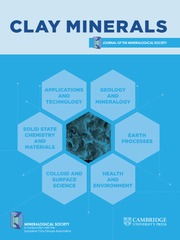Article contents
Estimation de la composition chimique d'un phyllosilicate secondaire en equilibre avec une population homogene d'eaux
Published online by Cambridge University Press: 09 July 2018
Resume
Deux questions sont abordées: (1) Une eau naturelle étant donnée, peut-on considérer qu'elle est en équilibre avec un minéral de formule connue? (2) Un ensemble homogène d'eaux naturelles étant donné, peut-on considérer que ces eaux sont en équilibre avec un minéral? Si oui, Peut-on proposer une estimation de la composition de ce mineral? Nous proposons une méthode pour répondre à chacune de ces deux questions. Cette methode est appliquée à l'estimation de minéraux argileux de formule générale Sia Alb Mgc Cad Ke Naf On (OH)m . Les données utilisées sont des eaux de percolation, dans des colonnes de sols.
Abstract
The following two problems are considered: (1) For a given natural water, the distance to equilibrium with respect to given minerals is more conveniently expressed as an euclidian distance to an n-dimensional plane than as the classical thermodynamic distance (log Q/K). (2) For a given set of natural waters assumed to be in equilibrium with a single unknown mineral, it is possible to estimate the chemical composition of this mineral by a quadratic programming method. This method is applied to the estimation of clay minerals of general formula Sia Alb Mgc Cad Ke Naf On OHm . Data are used from both ‘computed’ waters and waters obtained by experimental seepage through soil columns.
Information
- Type
- Research Article
- Information
- Copyright
- Copyright © The Mineralogical Society of Great Britain and Ireland 1985
References
Bibliographie
- 4
- Cited by

